Performance of MoS2/Zr Composite Coatings at Different Deposition Temperatures
Abstract
:1. Introduction
2. Materials and Methods
2.1. MoS2/Zr Coating Preparation
2.2. Friction Tests
3. Results and Discussion
3.1. Mechanical Properties
3.2. Friction Behaviors
4. Conclusions
- As the deposition temperature increased from 50 °C to 300 °C, the coating thickness and micro-hardness gradually increased, while the adhesion force was first increased and then decreased.
- The friction behaviors for the coated samples varied with the growth of deposition temperatures. The samples within the deposition temperature range from 180 °C to 250 °C possessed excellent friction properties and wear resistance.
- The main mechanisms responsible for the difference in the friction performance of the coatings were attributed to the changing mechanical performances of coatings caused by temperature variation. The MoS2/Zr coatings deposited at the temperature of 180 °C and 200 °C possessed preferable comprehensive mechanical and tribological properties.
Author Contributions
Funding
Institutional Review Board Statement
Informed Consent Statement
Data Availability Statement
Acknowledgments
Conflicts of Interest
References
- Dai, D.H.; Liu, M.; Yu, Z.M.; Wang, X. Modern Surface Technology; Central South University Press: Changsha, China, 2007; pp. 1–24. [Google Scholar]
- Olayinka, A.O.; Akinlabi, E.T.; Oladijo, O.P. Influence of sputtering parameters on the structural and mechanical properties of TiC thin film coating. Appl. Surf. Sci. 2020, 520, 146323. [Google Scholar]
- Fazel, Z.A.; Elmkhah, H.; Fattah-Alhosseini, A.; Babaei, K.; Meghdari, M. Comparing electrochemical behavior of applied CrN/TiN nanoscale multilayer and TiN single-layer coatings deposited by CAE-PVD method. J. Asian Ceram. Soc. 2020, 8, 510–518. [Google Scholar] [CrossRef] [Green Version]
- Kowalski, S. The influence of selected PVD coatings on fretting wear in a clamped joint based on the example of a rail vehicle wheel set. Eksploat. I Niezawodn. 2017, 20, 1–8. [Google Scholar] [CrossRef]
- Kowalski, S.; Cygnar, M.; Cieślikowski, B. Analysis of the application of ZrN coatings for the mitigation of the development of fretting wear processes at the surfaces of push fit joint elements. Proc. Inst. Mech. Eng. Part J J. Eng. Tribol. 2020, 234, 1208–1221. [Google Scholar] [CrossRef]
- Zhang, Y.; Yan, G.P.; You, K.Y.; Fang, F.Z. Study on α-Al2O3 anti-adhesion coating for molds in precision glass molding. Surf. Coat. Technol. 2020, 391, 125720. [Google Scholar] [CrossRef]
- Uak, N.; Aslantas, K.; Iek, A. The effects of Al2O3 coating on serrated chip geometry and adiabatic shear banding in orthogonal cutting of AISI 316L stainless steel. J. Mater. Res. Technol. 2020, 9, 10758–10767. [Google Scholar]
- Mishra, S.K.; Ghosh, S.; Aravindan, S. Investigations into friction and wear behavior of AlTiN and AlCrN coatings deposited on laser textured WC/Co using novel open tribometer tests. Surf. Coat. Technol. 2020, 387, 125513. [Google Scholar] [CrossRef]
- Das, S.; Guha, S.; Das, P.P.; Ghadai, R.K. Analysis of morphological, microstructural, electrochemical and nano mechanical characteristics of TiCN coatings prepared under N2 gas flow rate by chemical vapour deposition (CVD) process at higher temperature. Ceram. Int. 2020, 46, 10292–10298. [Google Scholar] [CrossRef]
- Sahoo, P.; Patra, K.; Singh, V.K.; Gupta, M.K.; Song, Q.H.; Mia, M.; Pimenov, D.Y. Influences of TiAlN coating and limiting angles of flutes on prediction of cutting forces and dynamic stability in micro milling of die steel (P-20). J. Mater. Process. Technol. 2020, 278, 116500. [Google Scholar] [CrossRef]
- Chaar, A.B.B.; Rogström, L.; Johansson-Jöesaar, M.P.; Barrirero, J.; Aboulfadl, H.; Schell, N.; Ostach, D.; Mücklich, F.; Odén, M. Microstructural influence of the thermal behavior of arc deposited TiAlN coatings with high aluminum content. J. Alloys Compd. 2020, 854, 157205. [Google Scholar] [CrossRef]
- Lv, W.Z.; Li, G.J.; Zhou, Y.Y.; Liu, S.Y.; Wang, K.; Wang, Q. Effect of high hardness and adhesion of gradient TiAlSiN coating on cutting performance of titanium alloy. J. Alloys Compd. 2020, 820, 153137. [Google Scholar]
- Gu, J.B.; Li, L.H.; Ai, M.; Xu, Y.; Xu, Y.; Li, G.D.; Deng, D.C.; Peng, H.; Luo, S.D.; Zhang, P.P. Improvement of solid particle erosion and corrosion resistance using TiAlSiN/Cr multilayer coatings. Surf. Coat. Technol. 2020, 402, 126270. [Google Scholar] [CrossRef]
- Kumar, C.S.; Patel, S.K. Effect of duplex nanostructured TiAlSiN/TiSiN/TiAlN-TiAlN and TiAlN-TiAlSiN/TiSiN/TiAlN coatings on the hard turning performance of Al2O3-TiCN ceramic cutting tools. Wear 2019, 418–419, 226–240. [Google Scholar] [CrossRef]
- Shi, M.S. Solid Lubricating Materials; China Chemical Industry Press: Beijing, China, 2000; pp. 120–150. [Google Scholar]
- Hudec, T.; Mikula, M.; Satrapinskyy, L.; Roch, T.; Truchlý, M.; Švec, P.J.; Huminiuc, T.; Polcar, T. Structure, mechanical and tribological properties of Mo-S-N solid lubricant coatings. Appl. Surf. Sci. 2019, 486, 1–14. [Google Scholar] [CrossRef]
- Xing, Y.Q.; Wu, Z.; Yang, J.J.; Wang, X.S.; Liu, L. LIPSS combined with ALD MoS2 nano-coatings for enhancing surface friction and hydrophobic performances. Surf. Coat. Technol. 2020, 385, 125396. [Google Scholar] [CrossRef]
- Li, Y.T.; Xie, M.L.; Sun, Q.; Xu, X.J.; Fan, X.Q.; Zhang, G.A.; Li, H.; Zhu, M.H. The effect of atmosphere on the tribological behavior of magnetron sputtered MoS2 coatings. Surf. Coat. Technol. 2020, 378, 125081. [Google Scholar] [CrossRef]
- Sun, J.; Deng, J.X.; Li, X.M.; Meng, Y.; Zhang, Y.; Zhang, L.L.; Lu, Y. Preparation and tribological properties of MoS2-based multiple-layer structured films fabricated by electrohydrodynamic jet deposition. Surf. Coat. Technol. 2020, 384, 125334. [Google Scholar] [CrossRef]
- Sun, S.Q.; Chen, J.; Wang, Y.X.; Wang, L.P.; Sun, Z.M. Structural sensitivity of MoS2-based films in solid space lubrication. Surf. Eng. 2020, 36, 106–113. [Google Scholar] [CrossRef]
- Sadeghi-Dehsahraee, M.; Najafisayar, P. Electrodeposition and Characterization of Cr-MoS2 composite coatings. J. Mater. Eng. Perform. 2019, 28, 5674–5690. [Google Scholar] [CrossRef]
- Kao, W.H. Tribological properties and high speed drilling application of MoS2-Cr coatings. Wear 2005, 258, 812–825. [Google Scholar] [CrossRef]
- Zeng, C.; Pu, J.B.; Wang, H.X.; Zheng, S.J.; Wang, L.P.; Xue, Q.J. Study on atmospheric tribology performance of MoS2-W films with self-adaption to temperature. Ceram. Int. 2019, 45, 15834–15842. [Google Scholar] [CrossRef]
- Duan, Z.W.; Qiao, L.; Chai, L.Q.; Xu, J.; Wang, P.; Liu, W.M. Structure, properties and growth mechanism of a self-assembled nanocylindrical MoS2/Mo-S-C composite film. Appl. Surf. Sci. 2019, 465, 564–574. [Google Scholar] [CrossRef]
- Yi, J.; Li, M.L.; Zhou, H.X.; Rosenkranz, A.; Wang, B.; Song, H.; Jiang, N. Enhanced tribological properties of Y/MoS2 composite coatings prepared by chemical vapor depositon. Ceram. Int. 2020, 46, 23813–23819. [Google Scholar] [CrossRef]
- Man, Y.; Zhang, G.J.; Ba, Y.W.; Wang, T.; Wang, X.; Liu, Z.N. Microstructure and tribological properties of MoS2+Zr composite coatings in high humidity environment. Appl. Surf. Sci. 2016, 367, 140–146. [Google Scholar]
- Deng, J.X.; Song, W.L.; Zhang, H.; Zhao, J.L. Friction and wear behaviours of MoS2/Zr coatings against hardened steel. Surf. Eng. 2008, 24, 410–415. [Google Scholar] [CrossRef]
- Song, W.L.; Wang, Z.C.; Deng, J.X.; Zhou, K.; Wang, S.J.; Guo, Z.X. Cutting temperature analysis and experiment of Ti-MoS2/Zr-coated cemented carbide tool. Int. J. Adv. Manuf. Technol. 2017, 93, 799–809. [Google Scholar] [CrossRef]
- Deng, J.X.; Song, W.L.; Zhang, H.; Zhao, J.L. Performance of PVD MoS2/Zr-coated carbide in cutting processes. Int. J. Mach. Tools Manuf. 2008, 48, 1546–1552. [Google Scholar]
- Song, W.L.; Wang, S.J.; Xia, Z.X.; Zhang, Q.G. Effect of Zr target current on the mechanical and tribological performance of MoS2-Zr composite lubricating coatings. Coatings 2020, 10, 80. [Google Scholar] [CrossRef] [Green Version]
- Song, G.H.; Du, H.; He, C.L. Hard and Super Hard Coatings; China Chemical Industry Press: Beijing, China, 2007; pp. 25–85. [Google Scholar]


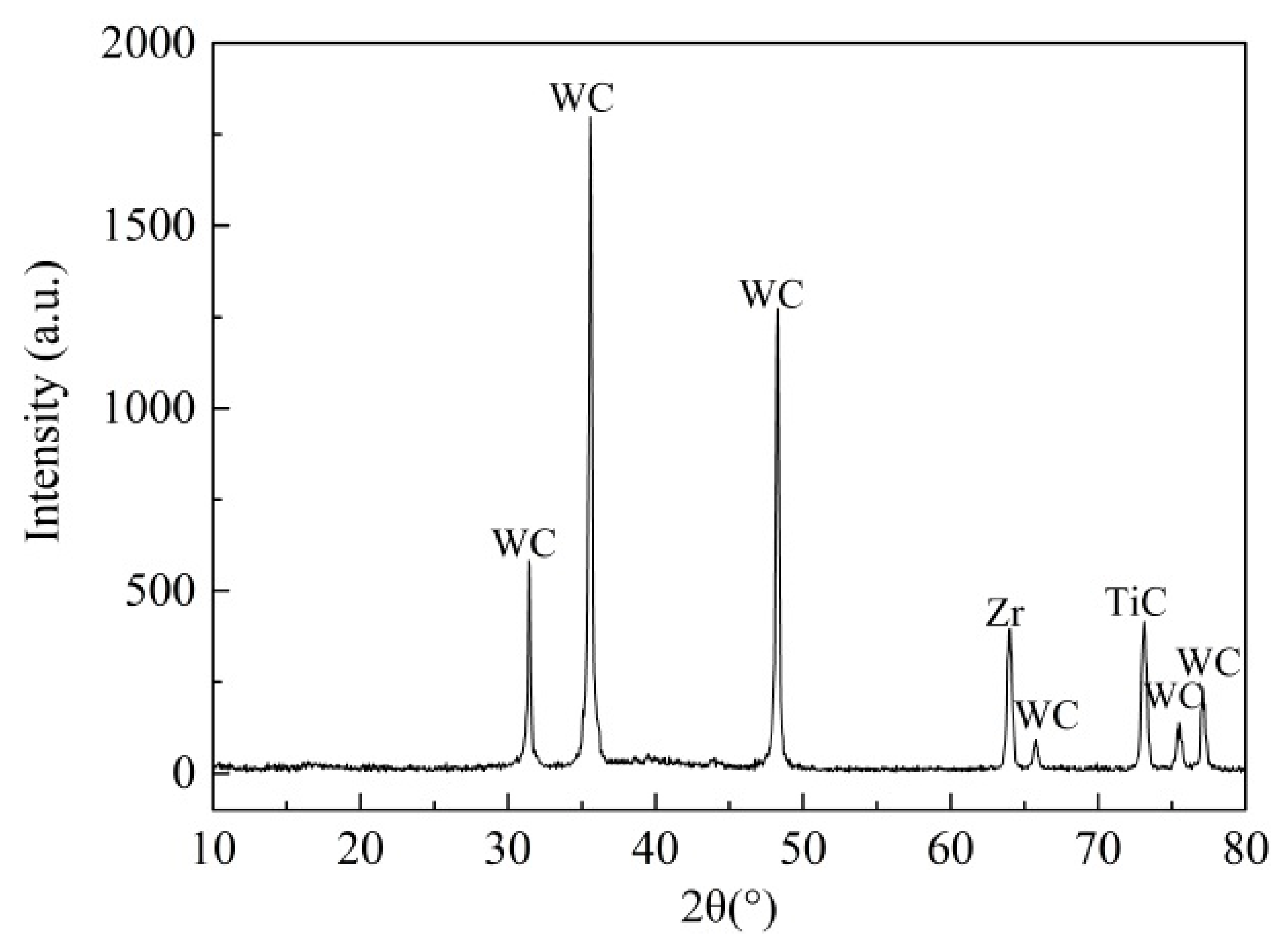
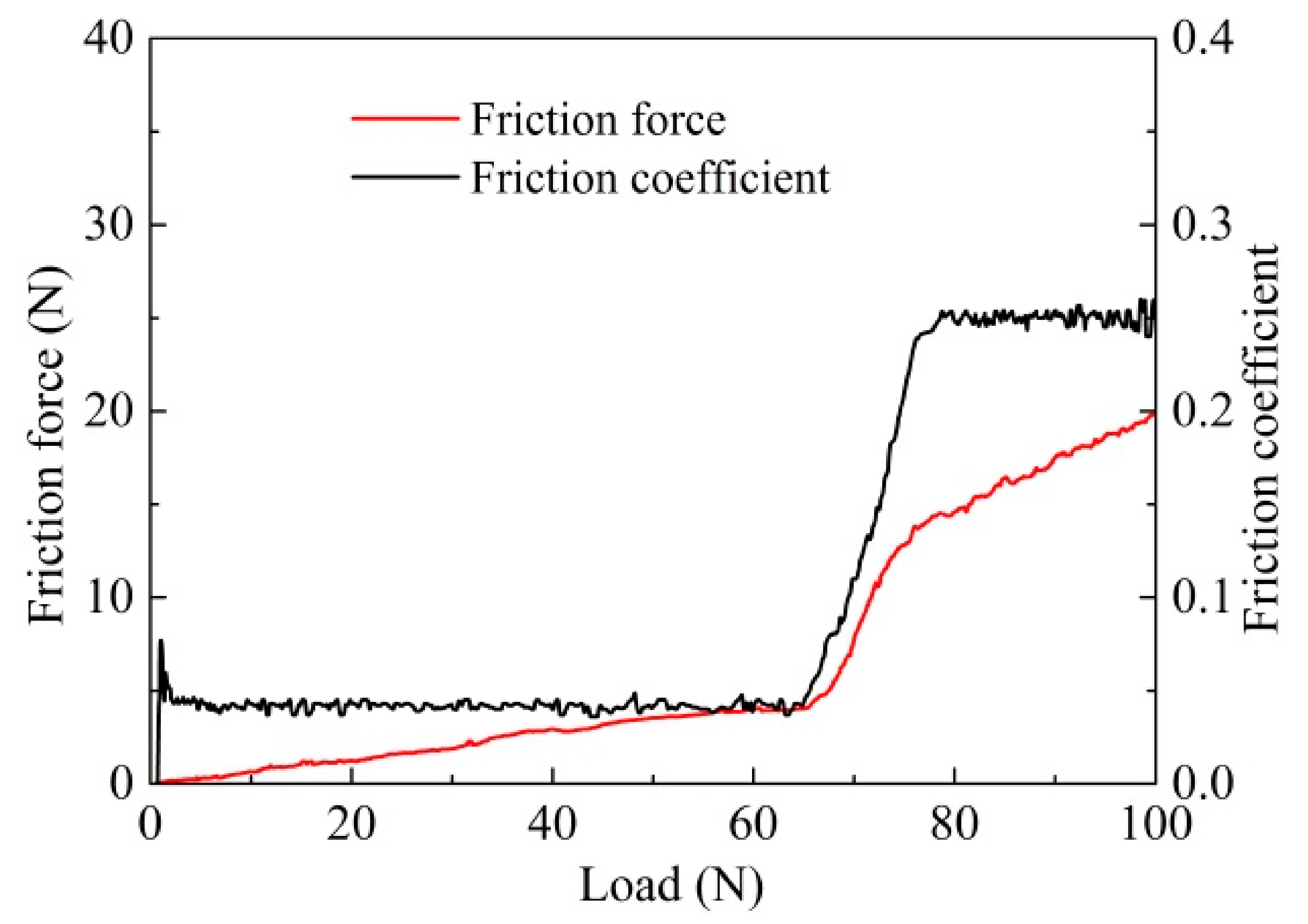
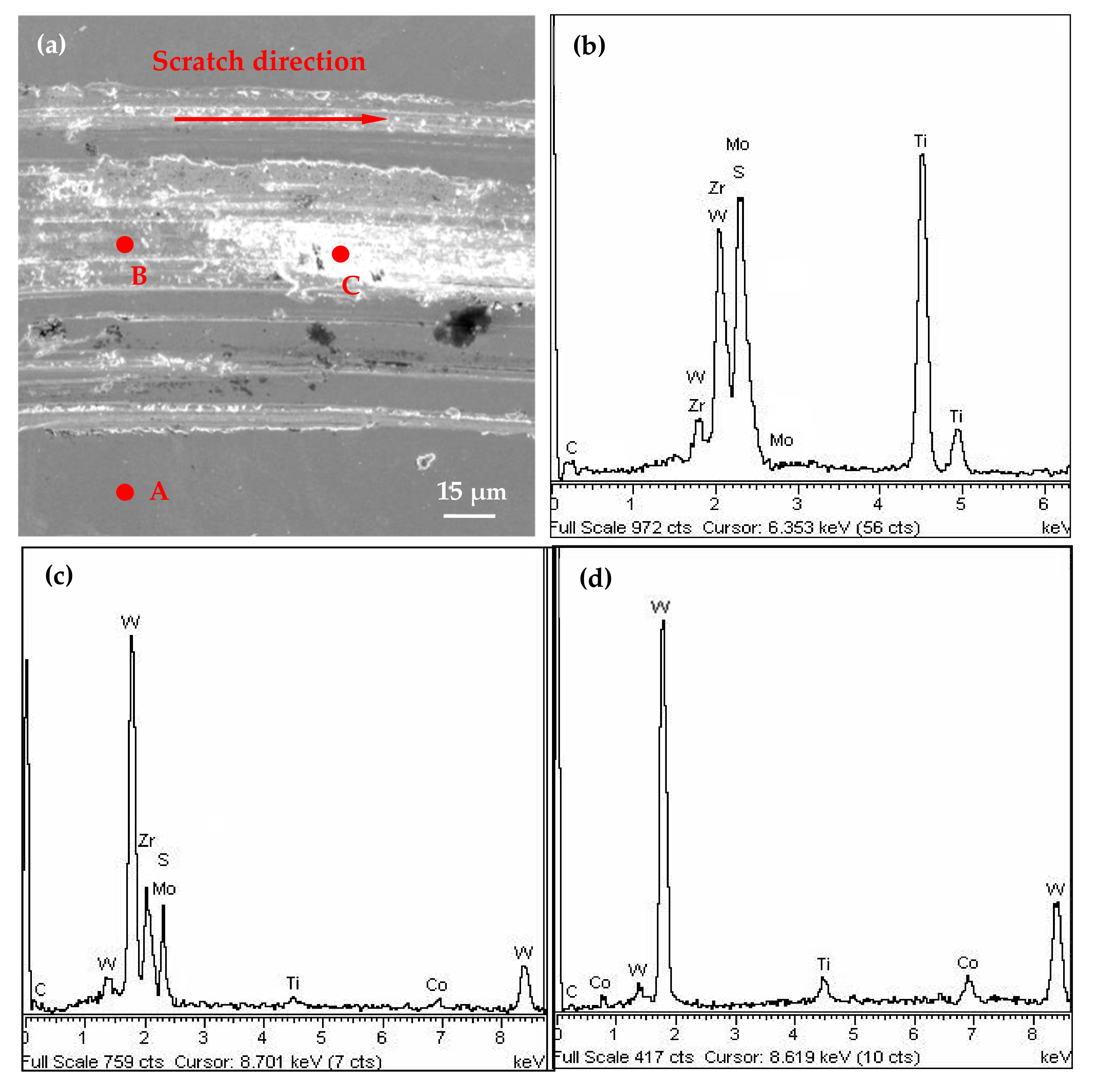

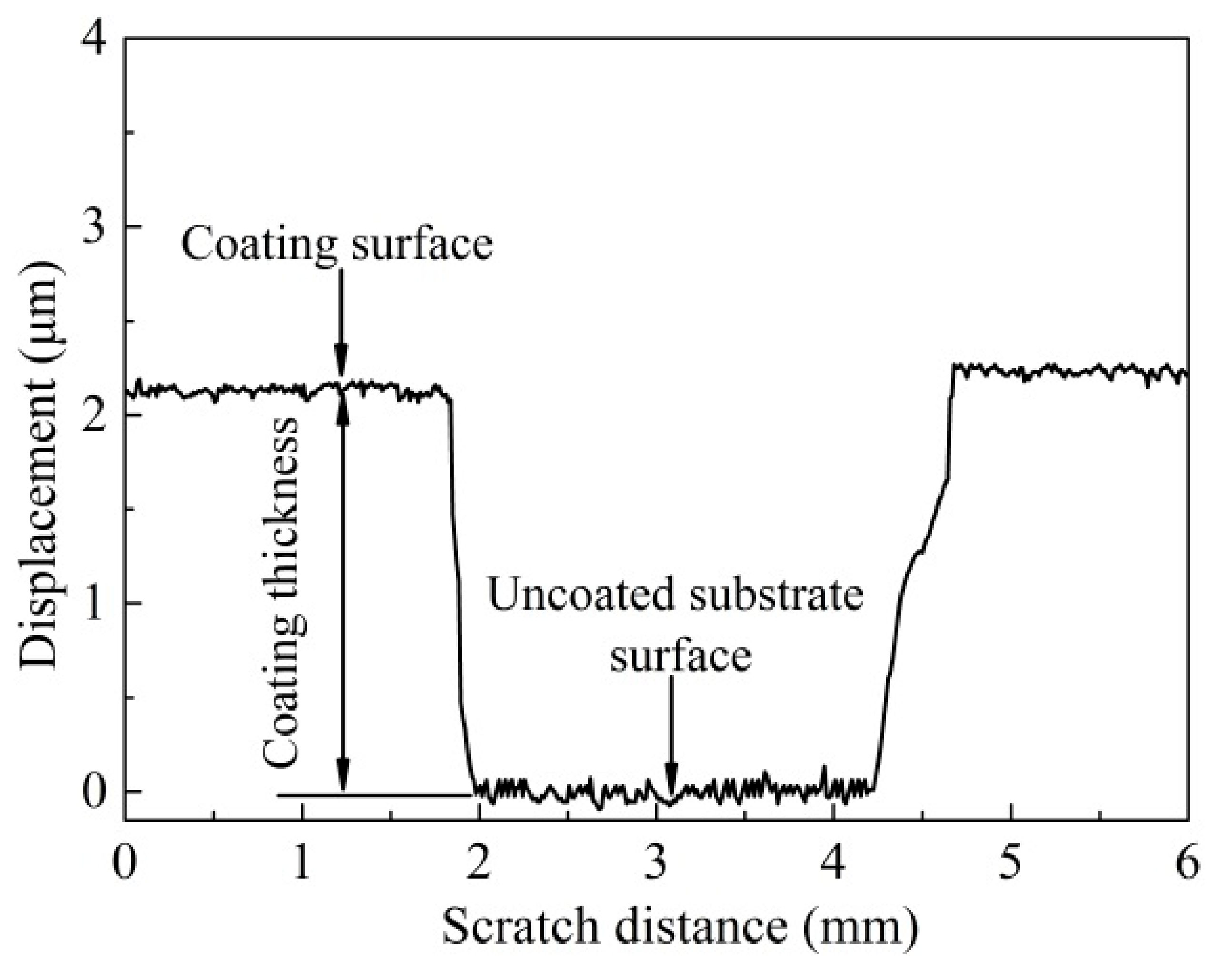
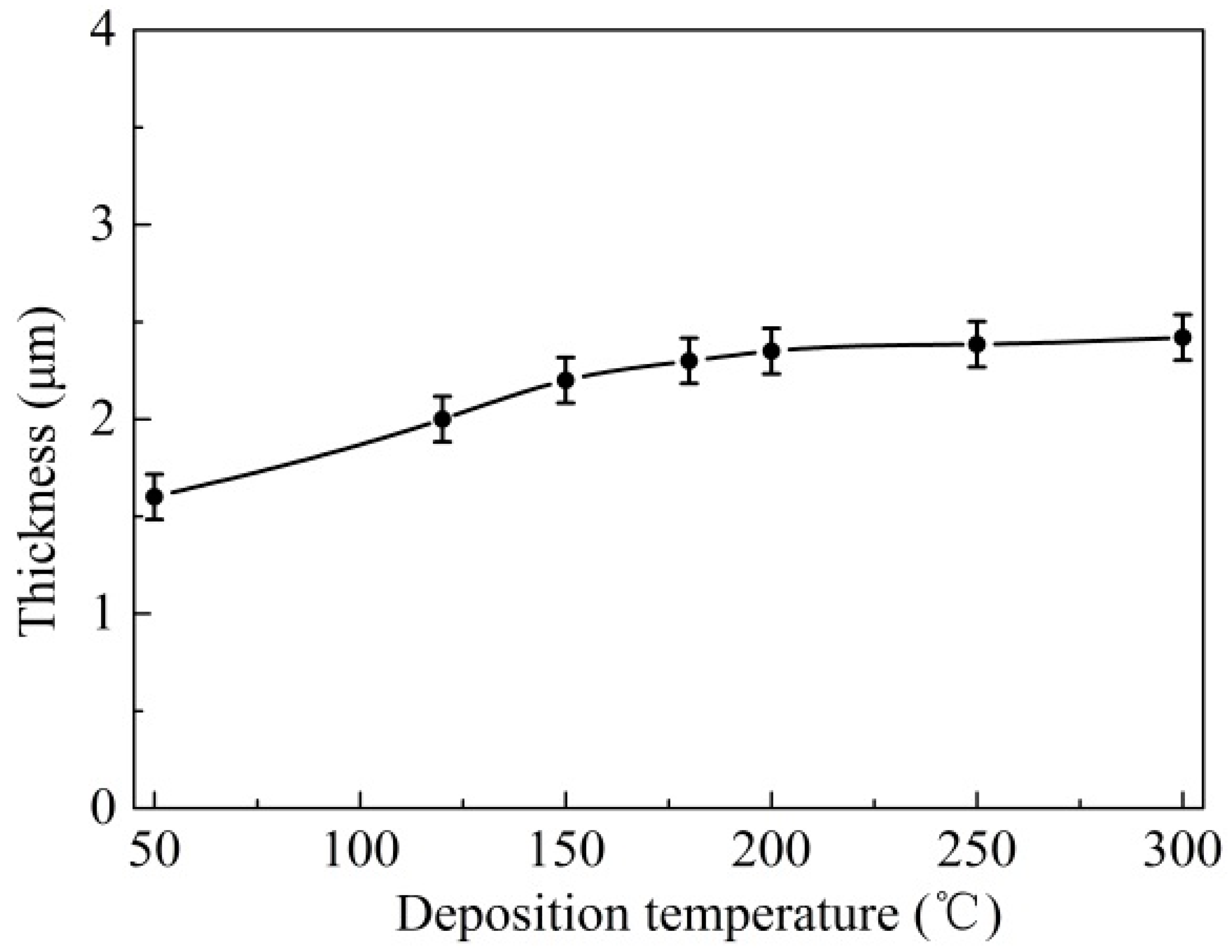
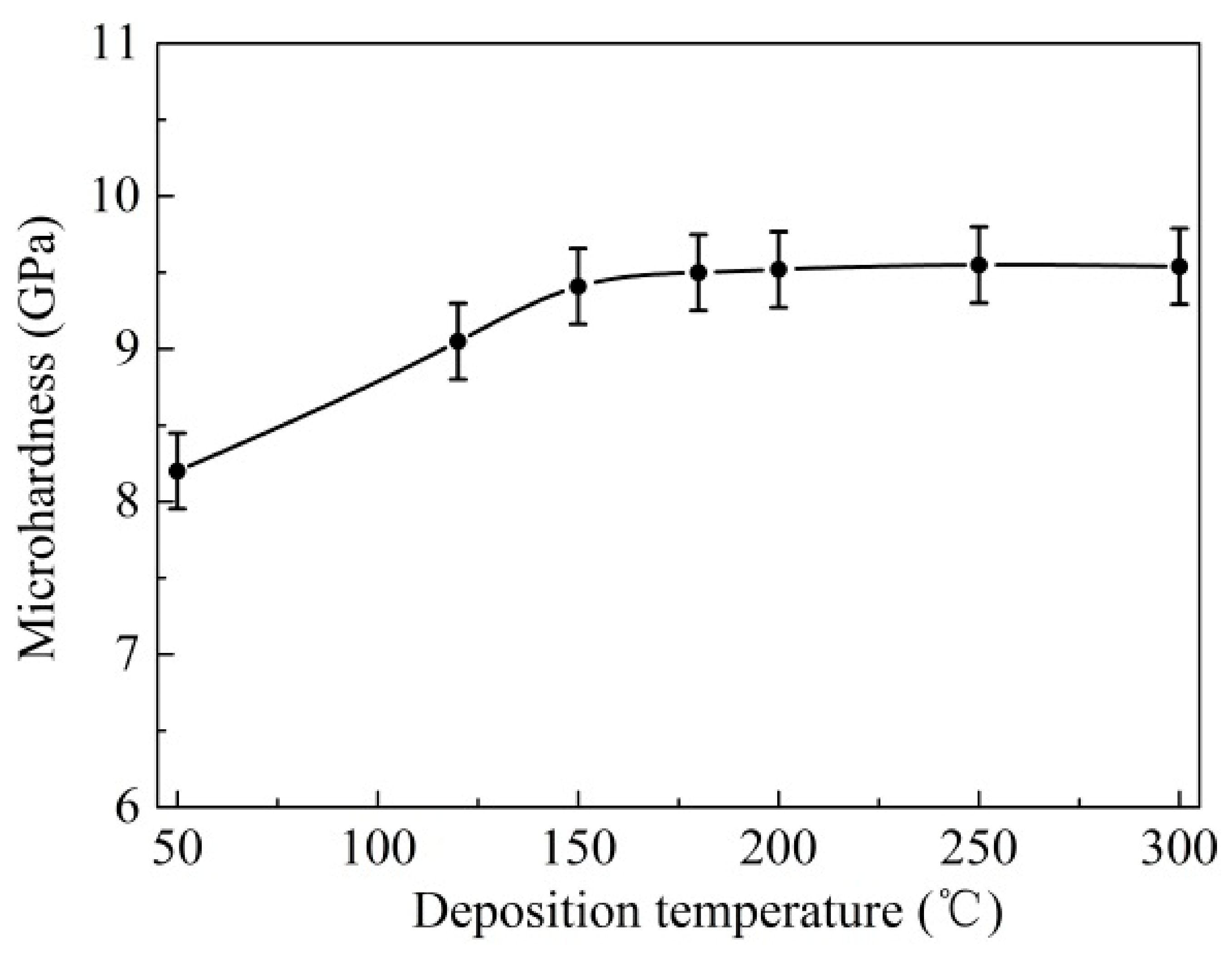
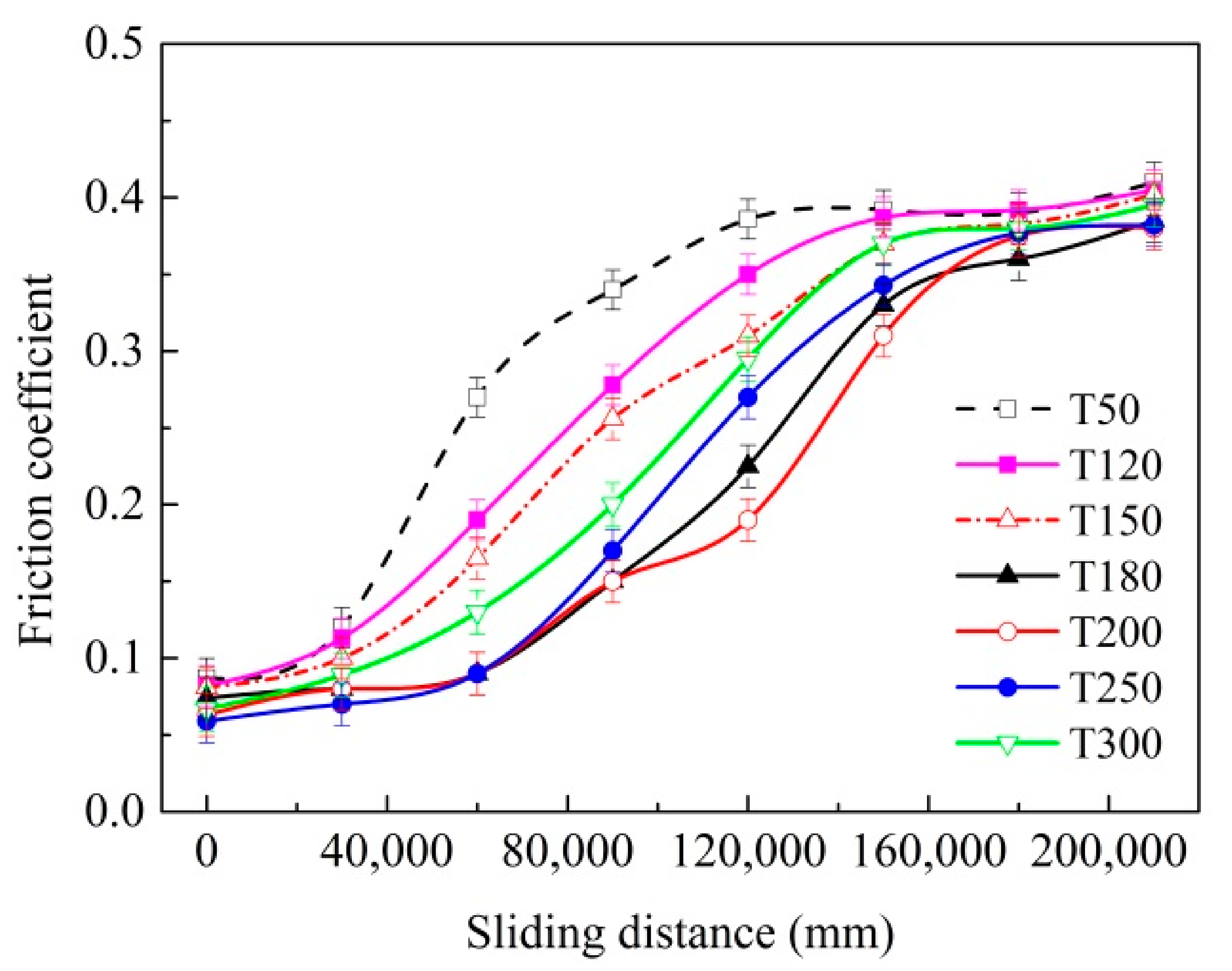

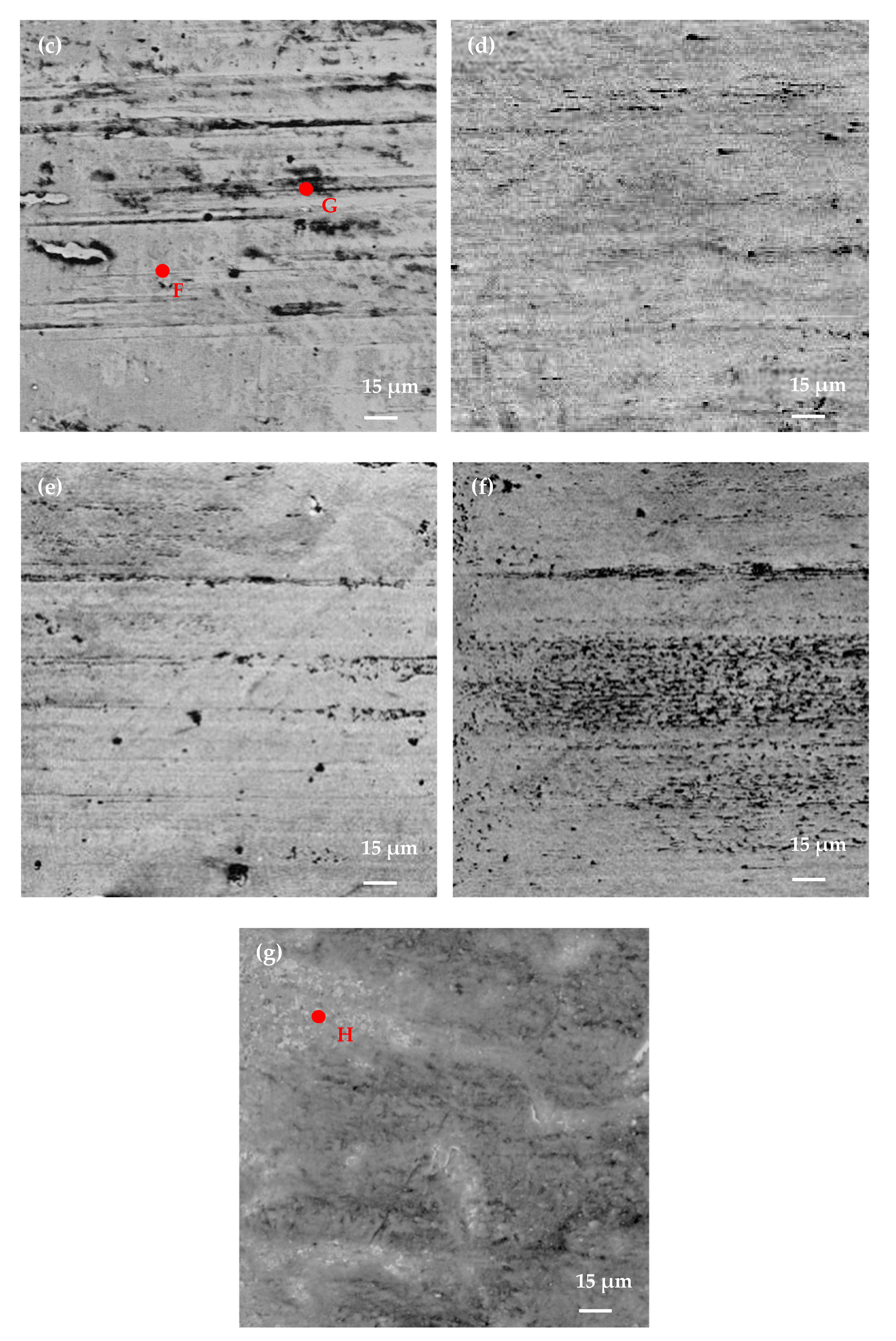
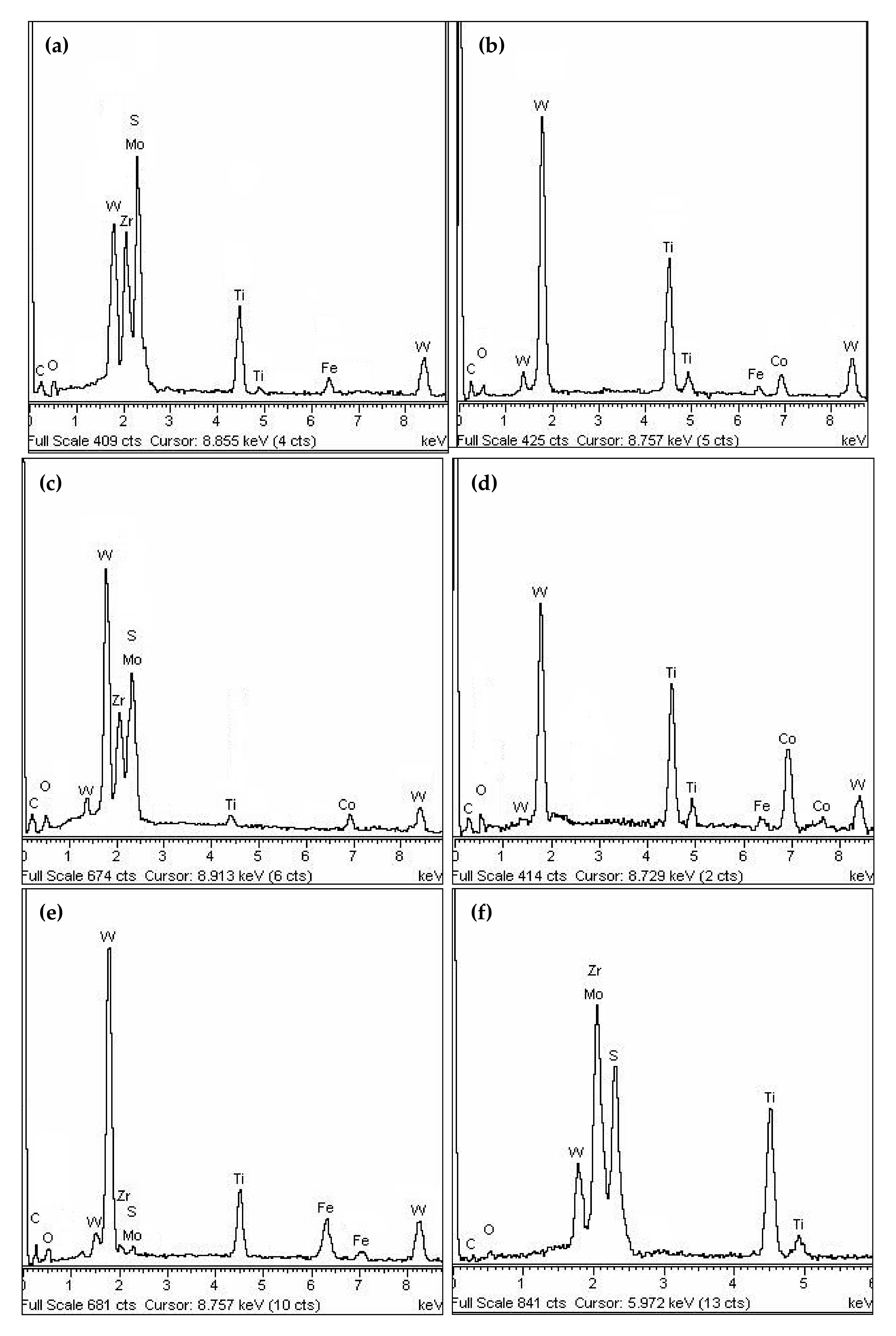
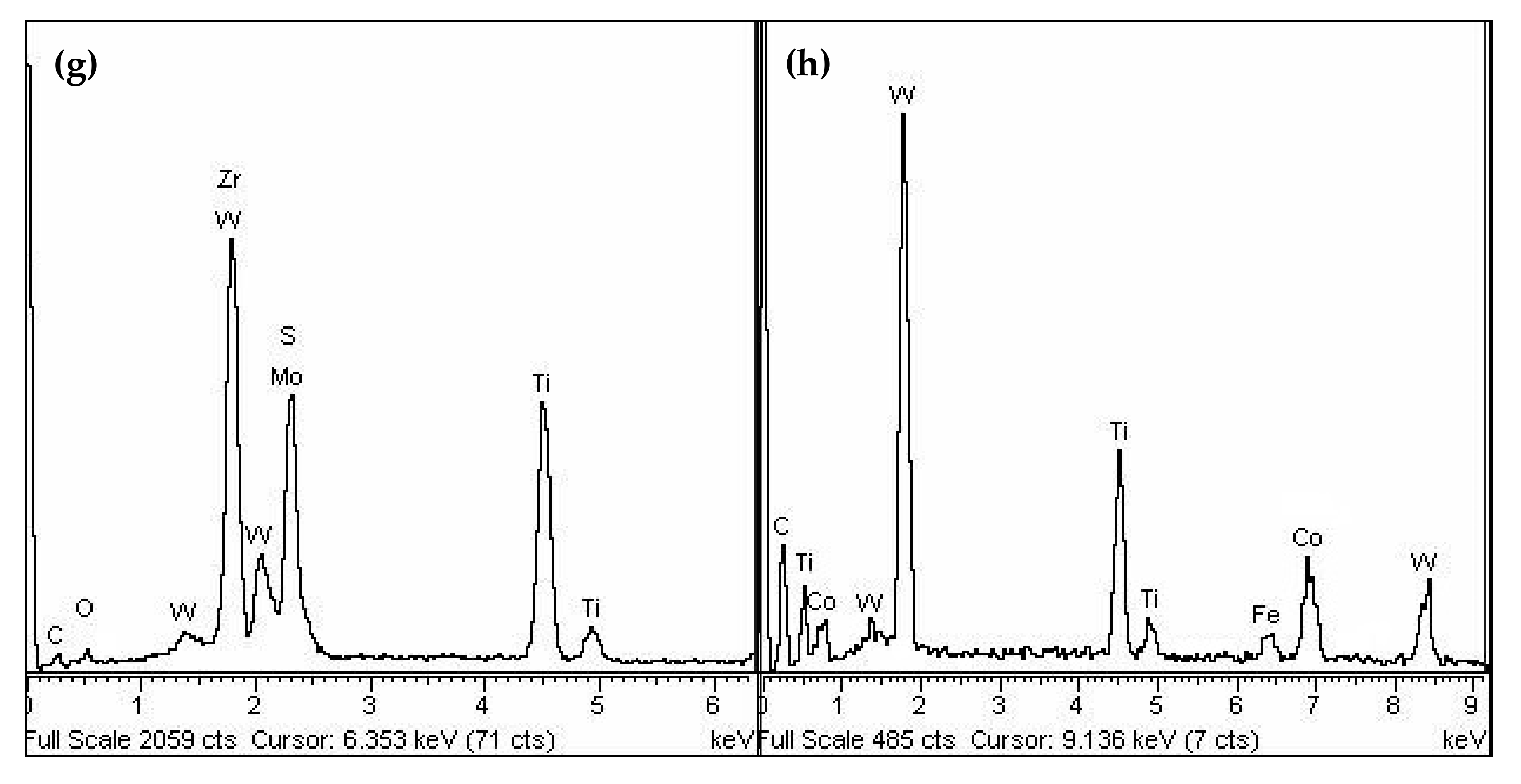
| Base Pressure (×10−3 Pa) | Ar Pressure (Pa) | Bias Voltage (V) | MoS2 Current (A) | Zr Current (A) | Deposition Time (min) | Temperature (°C) |
|---|---|---|---|---|---|---|
| 6.50 | 0.50 | −200 | 1.60 | 60 | 100 | 50–300 |
Publisher’s Note: MDPI stays neutral with regard to jurisdictional claims in published maps and institutional affiliations. |
© 2021 by the authors. Licensee MDPI, Basel, Switzerland. This article is an open access article distributed under the terms and conditions of the Creative Commons Attribution (CC BY) license (https://creativecommons.org/licenses/by/4.0/).
Share and Cite
Song, W.; Sun, K.; Zhao, G.; Zhu, L.; Wang, S.; Li, T. Performance of MoS2/Zr Composite Coatings at Different Deposition Temperatures. Materials 2021, 14, 5100. https://doi.org/10.3390/ma14175100
Song W, Sun K, Zhao G, Zhu L, Wang S, Li T. Performance of MoS2/Zr Composite Coatings at Different Deposition Temperatures. Materials. 2021; 14(17):5100. https://doi.org/10.3390/ma14175100
Chicago/Turabian StyleSong, Wenlong, Kai Sun, Guangming Zhao, Long Zhu, Shoujun Wang, and Tianya Li. 2021. "Performance of MoS2/Zr Composite Coatings at Different Deposition Temperatures" Materials 14, no. 17: 5100. https://doi.org/10.3390/ma14175100
APA StyleSong, W., Sun, K., Zhao, G., Zhu, L., Wang, S., & Li, T. (2021). Performance of MoS2/Zr Composite Coatings at Different Deposition Temperatures. Materials, 14(17), 5100. https://doi.org/10.3390/ma14175100





